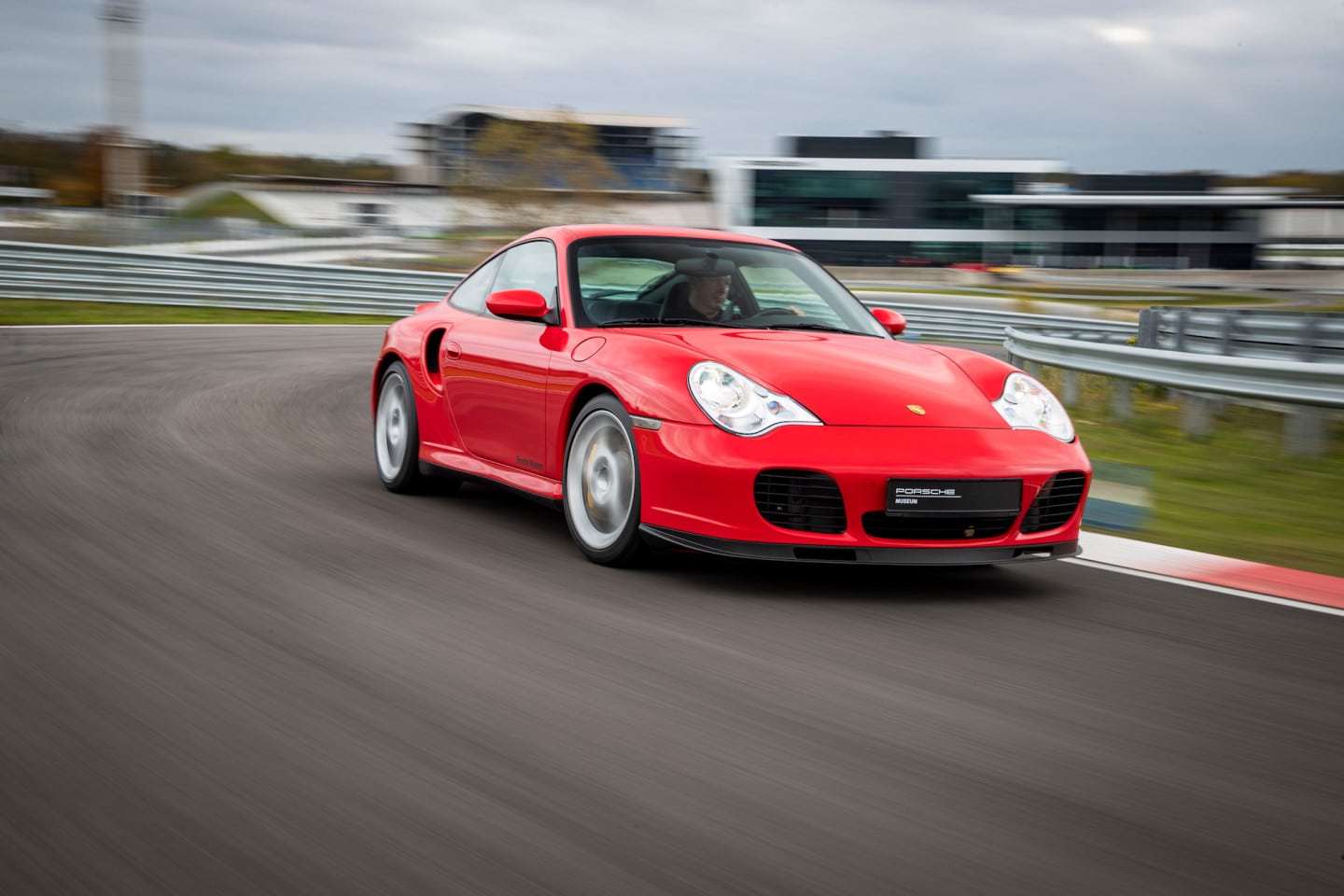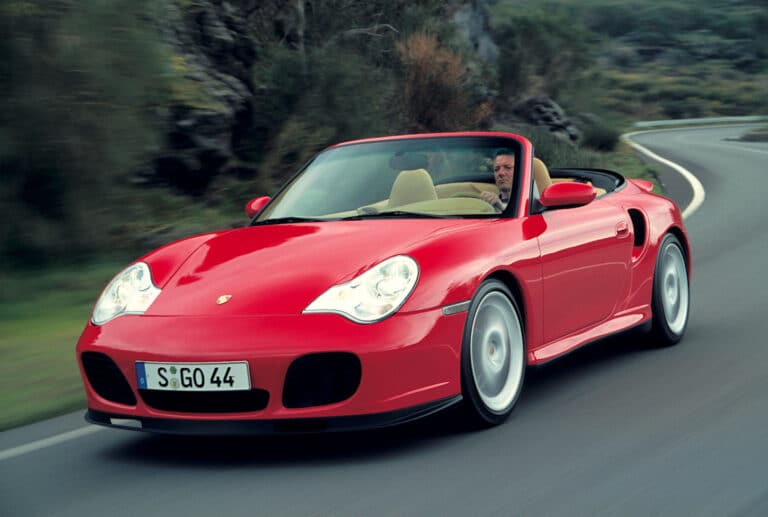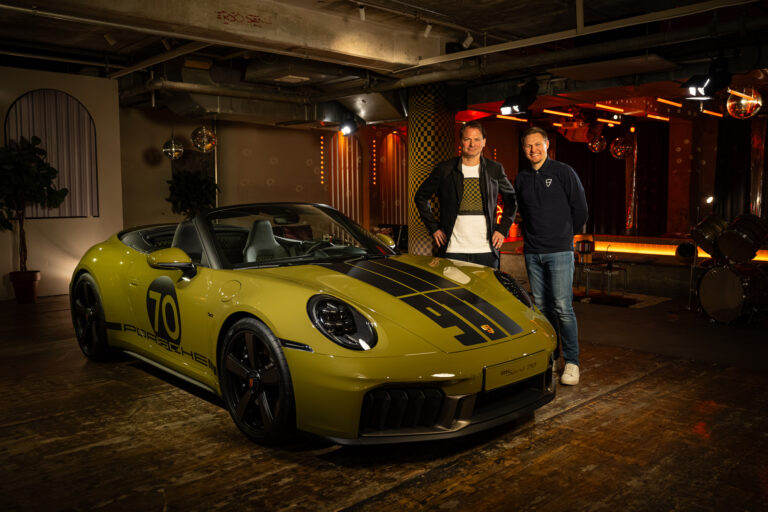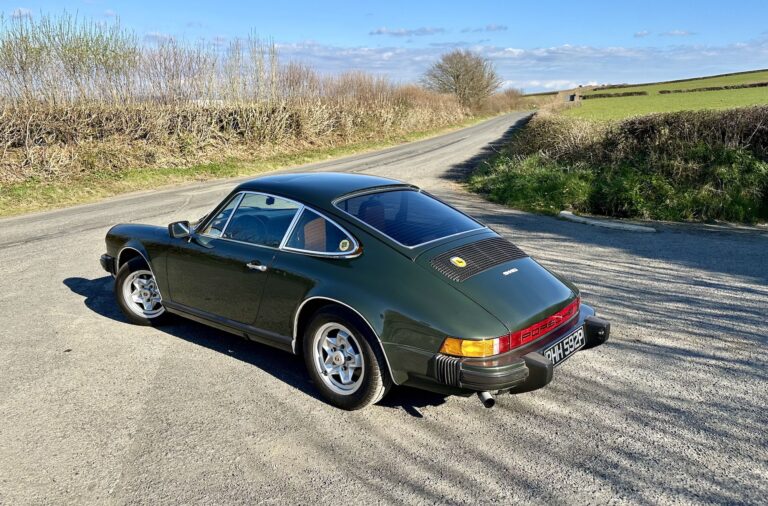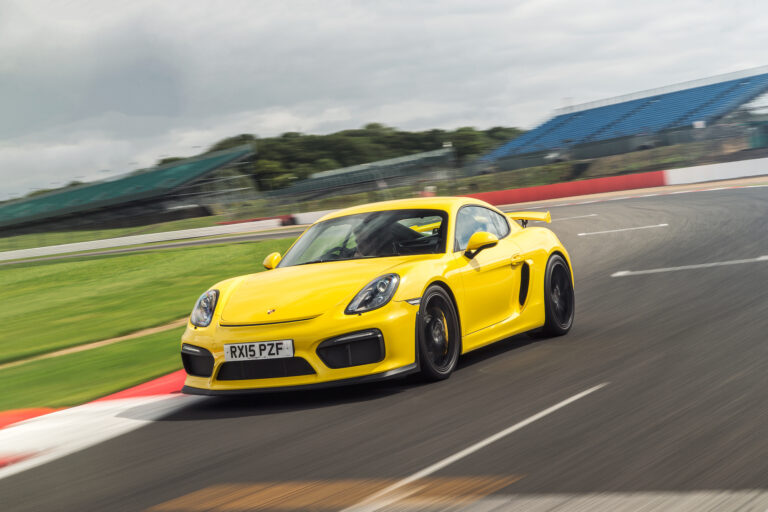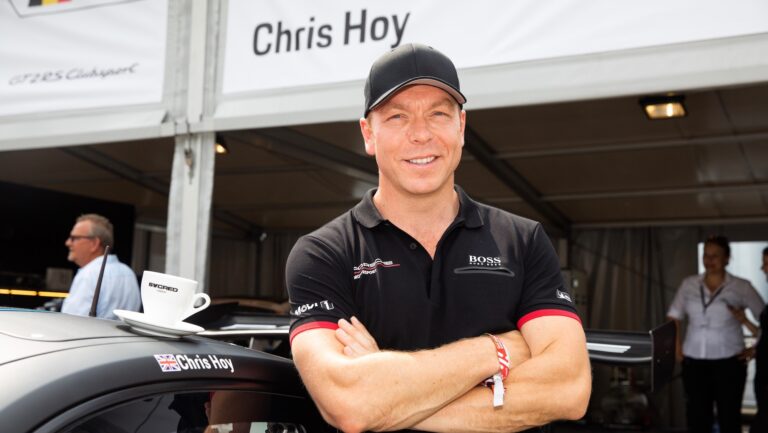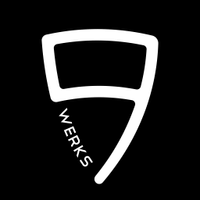 By Tim Pitt
11 months ago
By Tim Pitt
11 months ago
Porsche 996 Turbo buyer’s guide
The complete 9WERKS guide to buying a Porsche 996 Turbo, with expert advice from Paragon Porsche and Philip Raby Specialist Cars
Why should you buy one?
The 996 Turbo combines scintillating speed with comfort and everyday usability. It’s great value for money, too, plenty of examples available on the marketplace to choose from.
Porsche 996 Turbo: the key facts
Its air-cooled 993 predecessor had put the 911 Turbo through finishing school, reforming it from a wayward witwenmacher into a luxurious, all-weather supercar. And the water-cooled 996, launched in 2001, followed a similar template, with twin turbochargers to reduce lag and four-wheel drive for assured traction. Priced at around £86,000 new, it was fast enough to embarrass Italian exotics costing well into six figures.
The 996 clearly shared many parts with the 986 Boxster, but the Turbo immediately set itself apart – both in terms of how it looked and the performance on offer. Whether you saw one on the street or were lucky enough to get behind the wheel, there was no mistaking this special 911 for a cooking Carrera.
For starters, the Turbo ditched the 996’s divisive ‘fried egg’ headlights, with new, pointier lamps adopted by the rest of the range for the 996.2 facelift in 2002. It also had a squarer jaw, new air intakes behind the doors and the 66mm-wider hips of a Carrera 4. Further visual giveaways included ‘Big Red’ brake calipers, hollow-spoke alloy wheels and an active rear spoiler, which popped up at speeds above 75mph (don’t tell the motorway police).
Under the curvaceous ‘Turbo’ script on the engine lid lurked a derivative of the motorsport-derived ‘Mezger’ flat-six, as found in the 911 GT1 Le Mans racer and contemporary 996 GT3. Its raw numbers – 420hp, 560Nm, 0-62mph in 4.2 seconds and a top speed of 189mph – still impress today, particularly in a package weighing a modest 1,540kg.
Buyers could opt for six-speed manual or five-speed Tiptronic automatic transmissions, the latter blunting performance slightly to 0-62mph in 4.9 seconds and a 185mph maximum. In 2002, Porsche also introduced the X50 upgrade pack, with more boost, uprated intercoolers and a remapped ECU for an extra 30hp and 0-62mph in 4.0 seconds. This later became standard equipment on the run-out 996 Turbo S.
Inside, the Turbo was comprehensively equipped, with standard leather trim, electric seats, air conditioning and an electric sunroof, plus a premium Bose audio system from 2002. In total, 20,499 examples of the 996 Turbo left Zuffenhausen between 2001 and 2005.
With plenty of choice and prices from around £30,000, the 996 is a very appealing – and relatively affordable – route into 911 Turbo ownership. Check out the 9WERKS Marketplace for a selection of cars for sale from approved Porsche specialists.
Categories
How does the Porsche 996 Turbo drive?
“A 996 Turbo is easy to drive, but it still feels like a 911.” says Philip Raby, founder of Philip Raby Specialist Cars. “It just does everything so well, from pootling to the shops to a track day. I think they’re astonishing.”
Writing for Total 911 magazine, Kyle Fortune was even more succinct: “It’s a car you could quite easily use everyday, in all conditions, without compromise.”
Don’t go thinking the Turbo has been entirely tamed, though; this is still a brutally quick and exciting car. The boost comes in hard at 3,000rpm, then tails off after the 6,000rpm peak, but keep the flat-six within its power band and the 996 Turbo piles on speed with manic intensity. It’s still fast today, which is why it’s perennially popular in the marketplace.
The 996 is also more analogue and engaging than recent iterations of the Turbo. Its control weights are light, but feel finely judged, and a modest footprint (70mm narrower than a 992 Turbo) makes the performance easier to exploit. Few cars offer such point-to-point pace.
Criticisms? Well, the 996 Turbo pushes into understeer earlier than we’d like and it can get a little discombobulated on bumpy country lanes. In truth it errs more towards being a luxury GT than many 911s, feeling most at home on sweeping A-roads – or indeed an autobahn. If you buy one, be sure to arrange a road-trip to Germany…
Talking of long-distance comfort, don’t immediately rule out the Tiptronic gearbox. It isn’t as sharp or sophisticated as the dual-clutch DSG ’box introduced on the 997.2, but it arguably suits the character of the car. “I think the Tiptronic works really well with the turbocharged engine,” adds Philip Raby. “There’s plenty of torque, so you can just leave it in automatic mode – or use the buttons on the steering wheel.”
We should also point out that, like any car of this age, driving experiences will differ depending on the 996 Turbo in question. Jason Shepherd of Paragon Porsche says: “One that drives the way it did when it left Stuttgart is a really fine thing. But this isn’t a car you take a punt on, as the repair and recommissioning costs can be huge. You need to buy well or simply not buy.”
Porsche 996 Turbo: evolution of tech
If the 996 represented a revolution, the Turbo was more a logical evolution. Faster, more luxurious and more capable, it was a fitting flagship for the 911 range – while also being very distinct from the then-new GT3.
Don’t confuse the 3,600cc engine powering the Turbo with the 3,600cc unit in Gen2 versions of the 996 Carrera. The latter used the M96 motor – known for costly intermediate shaft (IMS) bearing failures – but the Turbo boasts the race-proven ‘Megzer’ engine. “If maintained properly, it’s extremely strong and reliable,” says Jamie Tyler of Paragon.
The Turbo’s viscous-couple 4WD system sends just five percent of torque to the front tyres in normal driving, maintaining the feel of a rear-driven car. However, this can increase to 40 percent when required, such as when accelerating hard on a wet road. Standard-fit Porsche Stability Management (PSM) and traction control keep everything pointing in the right direction, too.
Porsche Carbon Ceramic Brakes (PCCB) were introduced in 2001 on the 996 GT2 and became an option on the Turbo shortly afterwards. The standard brakes are 330mm steel discs – and amply up to the job. “You simply don’t need carbon brakes on a road car,” says Philip Raby.
The 996 Turbo rides on 18-inch wheels with the familiar 911 suspension setup: McPherson struts at the front and a multi-link arrangement at the rear. Its 997 successor would introduce electronically controlled Porsche Active Suspension Management (PASM), but this generation of Turbo has passive dampers and thus no additional ‘Sport’ mode.
Post-launch additions to the 996 Turbo during its lifetime included electric boot and engine lid release buttons in late 2001, then rain-sensing wipers, cupholders, a Bose sound system and the optional X50 pack in 2002. The Turbo Cabriolet arrived in 2003 and had a separate aluminium hard-top as standard. If you buy one today, make sure it comes with the car.
After quite a short innings, the 996 Turbo bowed out in 2005. Its passing was marked by the special edition Turbo S, built for one year only, with the 450hp X50 upgrade and standard PCCB brakes. Only 1,563 were made.
What to look for when buying a Porsche 996 Turbo
“There’s a long list,” warns Jason Shepherd of Paragon. “Don’t forget, the 996 Turbo was a performance bargain for a long period of time, so many cars weren’t cared for as they should have been.”
The first thing to check for is any sign of accident damage or corrosion (two issues that could be related). “Pay close attention to the top mount turrets, inside all the wheelarches and the rear quarter panels,” says Jamie Tyler. Other known rust spots are around the bonnet latch and the door striker catches on either side.
Like many 911s, the 996 Turbo’s front mounted radiators and air conditioning condensers are prone to damage or blockages from stones, wet leaves and other road debris. Keep watch on the water temperature gauge when you test-drive the car, and check that the air-con blows cold. Philip Raby quotes between £400 and £500 to replace the condensers.
At the rear of the car, the spoiler’s hydraulic rams can leak, meaning it fails to pop up or looks skewed to one side. You can test its operation while parked via the button on the car’s dashboard. Philip Raby says both hydraulic or electric ram replacement kits are available, but either option will cost around £2,000 fitted.
In terms of the engine, the heat generated by the twin turbochargers can lead to corrosion and oil leaks. The turbo actuators can seize and vacuum hoses may have perished. Also, the left-hand turbo control valve link rod can corrode and stop the wastegate from functioning – thus there is no overboost safety. Keep an eye on the boost gauge when you drive the car. If it doesn’t respond quickly and pull strongly, something is awry.
A 996 Turbo should also feel “nimble and on its toes”, says Jason Shepherd of Paragon. If it doesn’t, a new set of dampers could be required. Listen for knocking sounds from the suspension: most likely caused by wear to the front lower ball joints or lower arm bushes.
The 996 interior isn’t as hard-wearing as some 911 generations, so check for damage to upholstery and plastic trim. Blocked drain holes can also cause water leaks and electrical issues. “Feel for damp carpets, including inside the front luggage compartment,” advises Philip Raby. “On the Cabriolet, the area where the roof folds down can retain water as well.”
Ideally, we’d look for oil changes every 6,000 miles as part of a comprehensive service history. Any Porsche specialist can also examine the engine’s ECU to reveal signs of over-revving. Above all, buy the best car you can, as 996 Turbo values haven’t reached a level where restoring a tired car is financially viable. We’d aim to spend at least £40,000 on a warrantied car from the likes of Philip Raby or Paragon.
Porsche 996 Turbo: the options worth having
As the flagship of the 911 range, the Turbo came well-equipped from the factory. However, there are a few optional extras worth seeking out.
Manual gearbox
The five-speed Tiptronic auto suits the Turbo well, but the six-speed manual is still the keen driver’s choice – and it commands a price premium (typically around £10,000, says Jamie Tyler).
Coupe body
Purists will also prefer the coupe, yet the style and open-air rush of a Turbo Cabriolet appeal to some. The drop-top Turbo is also much rarer.
X50 Powerkit
An extra 30 horses takes total output to 450hp: matching the 996 Turbo S. A desirable upgrade, although the standard car isn’t slow.
Steel brakes
The massive cost of replacing PCCB discs and pads means we’d favour the steel setup – unless you plan to take your 996 Turbo on-track.
Bose audio
The premium Bose sound system became standard after 2002, but was optional before that. It’s well worth having.
Bright colours
Most 996 Turbos were supplied in subtle shades of silver, grey, blue or black. As a result, bright paint colours such as Guards Red or Speed Yellow are quite sought-after.
Interior trim
As with paint colours, this one comes down to personal taste. We think the aluminium trim kit brightens the rather plasticky interior, whereas wood inserts look odd in a 996.
Porsche 996 Turbo: technical spec
Years produced: 2001-2005
Cars made: 20,499
Engine: Flat-six, 3,600cc, twin-turbocharged
Power: 420hp @ 6,000rpm
Torque: 560Nm @ 2,700-4,600rpm
Compression ratio: 9.4:1
Transmission: 6-speed manual or 5-speed Tiptronic S auto Suspension
Front: MacPherson struts, coil springs, anti-roll bar
Rear: Multi-link, coil springs, anti-roll bar
Wheels and tyres
Front: 8×18-inch; 225/40/R18
Rear: 11×18-inch; 295/30/R18
Length: 4,435mm
Width: 1,830mm
Weight: 1,540kg
0-62mph: 4.2 sec
Top speed: 189mph
Search the full range of quality Porsche for sale on the 9WERKS Marketplace, all supplied by reputable specialists with comprehensive warranties.
